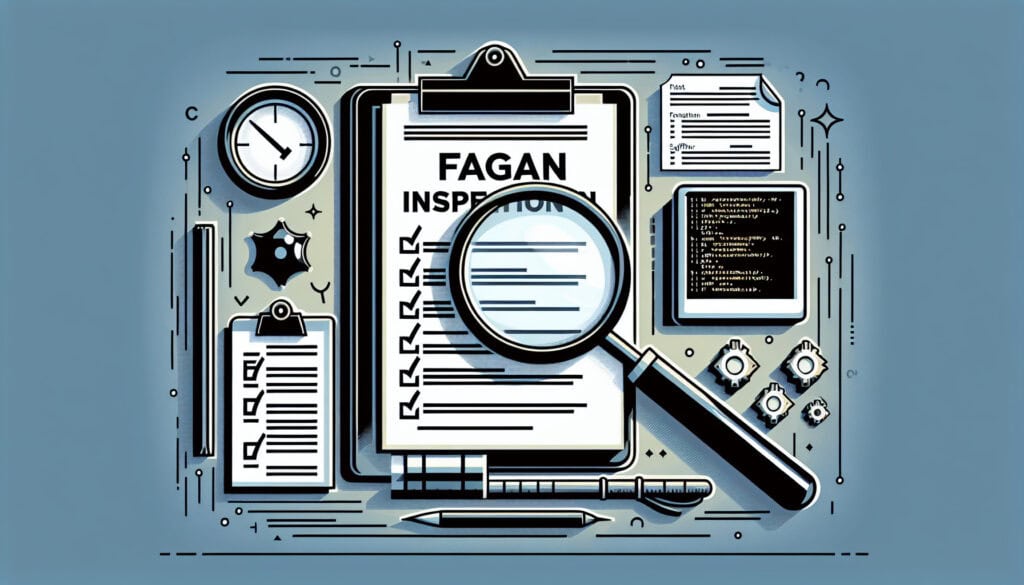A formal process for finding defects in documents and software.
- Methodologies: Customers & Marketing, Economics
Fagan Inspection

Fagan Inspection
- Agile Methodology, Design Review, Process Improvement, Process Optimization, Quality Assurance, Quality Control, Quality Management, Quality Management System (QMS), Software Testing
Objective:
How it’s used:
- A structured peer review process that involves defined roles, a set of steps (planning, overview, preparation, inspection, rework, and follow-up), and the use of checklists to identify defects in documents like requirements, design specifications, and code.
Pros
- Effective at finding defects early in the development process; Provides a structured and disciplined approach to review.
Cons
- Can be time-consuming and expensive to conduct; Requires trained participants and a formal process.
Categories:
- Engineering, Quality
Best for:
- Ensuring the quality of critical documents and code in a software project.
Fagan Inspection finds extensive applications in software engineering but is also beneficial across various industries including aerospace, automotive, telecommunications, and healthcare, particularly where product safety and adherence to regulations are paramount. This methodology clearly delineates roles such as the moderator, author, reviewers, and scribe, each contributing to a collaborative environment to ensure thorough analysis. The phased approach not only enhances document quality but also optimizes workflow, making it suitable for the early project stages, particularly during requirements gathering and design. An initial planning phase leads to an overview and preparation that sets the context for detailed inspection, where checklists guide reviewers in identifying discrepancies and omissions, ultimately resulting in actionable feedback for rework. Follow-up ensures that defects have been addressed, enabling iterative improvement. Practitioners typically include software engineers, quality assurance professionals, project managers, and subject matter experts, all of whom are encouraged to participate actively to foster an inclusive dialogue. Implementing Fagan Inspection within a project can significantly reduce costs and development time by preemptively addressing issues that might otherwise accumulate and escalate during later stages. In environments emphasizing due diligence and compliance, such as finance or pharmaceuticals, the robust nature of this methodology assures stakeholders that products will meet necessary standards before they reach the market.
Key steps of this methodology
- Conduct a planning meeting to outline inspection goals.
- Perform a walkthrough to familiarize participants with the material.
- Review the document or code according to the checklist.
- Identify defects and discuss findings among the team.
- Assign responsibility for rework of identified defects.
- Conduct a follow-up to ensure rework has been completed.
Pro Tips
- Involve stakeholders early in the Fagan Inspection process to clarify expectations and reduce misunderstandings.
- Utilize metrics from previous inspections to identify common defect types and improve checklist specificity.
- Encourage a culture of constructive feedback during inspections to enhance collaboration and knowledge sharing among team members.
To read and compare several methodologies, we recommend the
> Extensive Methodologies Repository <
together with the 400+ other methodologies.
Your comments on this methodology or additional info are welcome on the comment section below ↓ , so as any engineering-related ideas or links.
Historical Context
1962
1970
1972
1980
1980
1986
1986
1960
1963
1970
1980
1980
1980
1986
1987
(if date is unknown or not relevant, e.g. "fluid mechanics", a rounded estimation of its notable emergence is provided)















Related Posts
Musculoskeletal Discomfort Questionnaires
Multivariate Testing (MVT)
Multiple Regression Analysis
Motion Capture Systems
MoSCoW Method
Mood’s Median Test